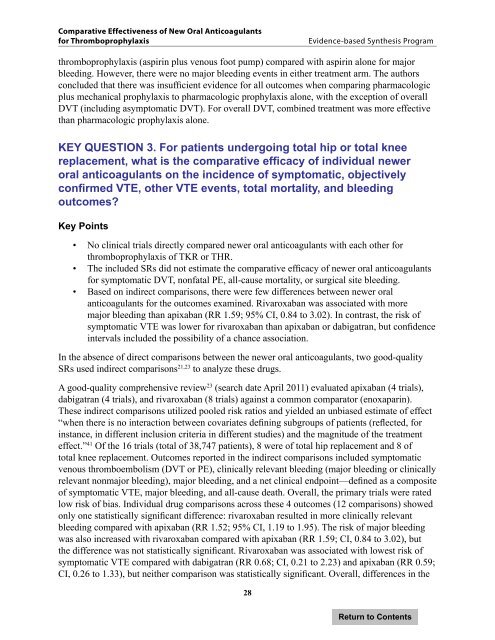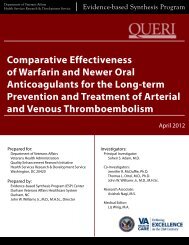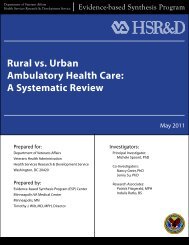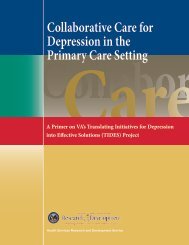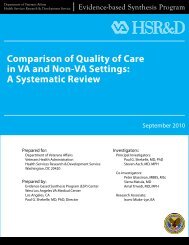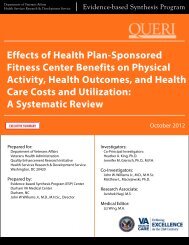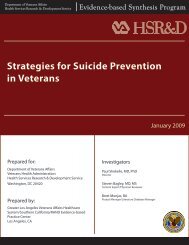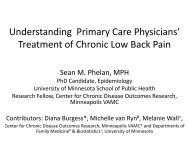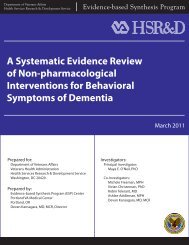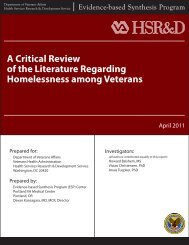Comparative Effectiveness of New Oral Anticoagulants for ...
Comparative Effectiveness of New Oral Anticoagulants for ...
Comparative Effectiveness of New Oral Anticoagulants for ...
Create successful ePaper yourself
Turn your PDF publications into a flip-book with our unique Google optimized e-Paper software.
<strong>Comparative</strong> <strong>Effectiveness</strong> <strong>of</strong> <strong>New</strong> <strong>Oral</strong> <strong>Anticoagulants</strong><br />
<strong>for</strong> Thromboprophylaxis<br />
Evidence-based Synthesis Program<br />
thromboprophylaxis (aspirin plus venous foot pump) compared with aspirin alone <strong>for</strong> major<br />
bleeding. However, there were no major bleeding events in either treatment arm. The authors<br />
concluded that there was insufficient evidence <strong>for</strong> all outcomes when comparing pharmacologic<br />
plus mechanical prophylaxis to pharmacologic prophylaxis alone, with the exception <strong>of</strong> overall<br />
DVT (including asymptomatic DVT). For overall DVT, combined treatment was more effective<br />
than pharmacologic prophylaxis alone.<br />
KEY QUESTION 3. For patients undergoing total hip or total knee<br />
replacement, what is the comparative efficacy <strong>of</strong> individual newer<br />
oral anticoagulants on the incidence <strong>of</strong> symptomatic, objectively<br />
confirmed VTE, other VTE events, total mortality, and bleeding<br />
outcomes?<br />
Key Points<br />
• No clinical trials directly compared newer oral anticoagulants with each other <strong>for</strong> <br />
thromboprophylaxis <strong>of</strong> TKR or THR.<br />
• The included SRs did not estimate the comparative efficacy <strong>of</strong> newer oral anticoagulants<br />
<strong>for</strong> symptomatic DVT, nonfatal PE, all-cause mortality, or surgical site bleeding.<br />
• Based on indirect comparisons, there were few differences between newer oral<br />
anticoagulants <strong>for</strong> the outcomes examined. Rivaroxaban was associated with more<br />
major bleeding than apixaban (RR 1.59; 95% CI, 0.84 to 3.02). In contrast, the risk <strong>of</strong><br />
symptomatic VTE was lower <strong>for</strong> rivaroxaban than apixaban or dabigatran, but confidence<br />
intervals included the possibility <strong>of</strong> a chance association.<br />
In the absence <strong>of</strong> direct comparisons between the newer oral anticoagulants, two good-quality<br />
SRs used indirect comparisons 21,23 to analyze these drugs.<br />
A good-quality comprehensive review 23 (search date April 2011) evaluated apixaban (4 trials),<br />
dabigatran (4 trials), and rivaroxaban (8 trials) against a common comparator (enoxaparin).<br />
These indirect comparisons utilized pooled risk ratios and yielded an unbiased estimate <strong>of</strong> effect<br />
“when there is no interaction between covariates defining subgroups <strong>of</strong> patients (reflected, <strong>for</strong><br />
instance, in different inclusion criteria in different studies) and the magnitude <strong>of</strong> the treatment<br />
effect.” 41 Of the 16 trials (total <strong>of</strong> 38,747 patients), 8 were <strong>of</strong> total hip replacement and 8 <strong>of</strong><br />
total knee replacement. Outcomes reported in the indirect comparisons included symptomatic<br />
venous thromboembolism (DVT or PE), clinically relevant bleeding (major bleeding or clinically<br />
relevant nonmajor bleeding), major bleeding, and a net clinical endpoint—defined as a composite<br />
<strong>of</strong> symptomatic VTE, major bleeding, and all-cause death. Overall, the primary trials were rated<br />
low risk <strong>of</strong> bias. Individual drug comparisons across these 4 outcomes (12 comparisons) showed<br />
only one statistically significant difference: rivaroxaban resulted in more clinically relevant<br />
bleeding compared with apixaban (RR 1.52; 95% CI, 1.19 to 1.95). The risk <strong>of</strong> major bleeding<br />
was also increased with rivaroxaban compared with apixaban (RR 1.59; CI, 0.84 to 3.02), but<br />
the difference was not statistically significant. Rivaroxaban was associated with lowest risk <strong>of</strong><br />
symptomatic VTE compared with dabigatran (RR 0.68; CI, 0.21 to 2.23) and apixaban (RR 0.59;<br />
CI, 0.26 to 1.33), but neither comparison was statistically significant. Overall, differences in the<br />
28


